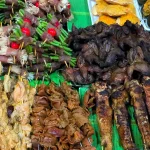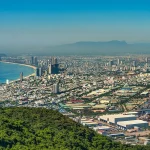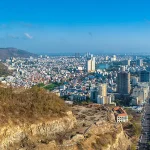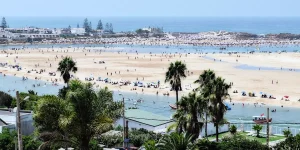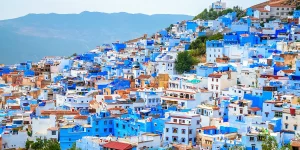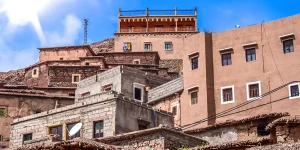Understanding Marrakesh
Marrakesh is a vibrant, chaotic city at the foot of the Atlas Mountains. This former imperial capital of Morocco offers a powerful sensory experience. The best things to do in Marrakesh revolve around exploring its historic medina, bustling souks, and hidden palaces. It’s a city for travelers who embrace intensity and thrive on cultural immersion.
However, visitors seeking quiet order or who are easily overwhelmed may find it challenging.
Table of Contents
One Minute History Lesson
Founded in the 11th century by the Almoravid dynasty, Marrakesh quickly became a major political, economic, and cultural center. Its strategic location made it a vital trading hub for caravans crossing the Sahara.
The city earned its nickname, the “Red City,” from the reddish-pink clay used to build its original ramparts and buildings.
Medina is the historic walled center of a Moroccan city. Inside its maze-like streets you’ll find markets, mosques, and traditional houses.
Souk is a traditional marketplace. Within its narrow lanes you’ll discover stalls overflowing with spices, textiles, leather goods, and handicrafts, often grouped by trade or craft.

Marrakesh at a Glance
- Known For: A maze medina, vibrant markets (souks), ornate palaces, and the lively Jemaa el-Fnaa square.
- Best Time to Visit: Spring (March to May) and autumn (September to November) offer pleasant weather for exploring.
- Getting There: Frequent trains connect from Casablanca and Fez. Modern buses (CTM, Supratours) run from most major cities, including Agadir.
- How Long to Stay: Two to three days covers the main sights. Add more time for day trips.
Planning Your Trip to Marrakesh
Best Time to Visit Marrakesh
The ideal seasons to visit Marrakesh are spring and fall. From March to May and September to November, daytime temperatures are warm and comfortable. This weather is perfect for walking through the medina and enjoying rooftop terraces.
Summer, from June to August, brings intense heat that often exceeds 100°F (38°C), making midday exploration difficult. Winters are mild but can be chilly, especially at night, though crowds are smaller.
How Long to Stay in Marrakesh
A stay of two to three days is ideal for a first-time visitor. This allows enough time to explore the main attractions within the medina without feeling rushed. A longer stay is justified if you plan to take day trips to the nearby Atlas Mountains or the Agafay Desert.
How to Get to Marrakesh: Transportation Options

Marrakesh is well-connected to other major cities in Morocco. From Casablanca, the most efficient option is the ONCF train, which takes about 2.5 hours and costs around 110–160 MAD ($11–16/€10–15). Trains depart from the Casa-Voyageurs station.
Getting from Fes to Marrakesh can be also dont with a direct ONCF trains that takes about 6.5–7 hours, with fares typically starting around 220 MAD ($22, €20).
Alternatively, overnight buses from CTM or Supratours offer a budget-friendly options.
From Agadir, comfortable buses are the best choice, taking about 3.5 hours and costing around 120 MAD ($12, €11).
Quick Costs & Money
Understanding local prices helps with budgeting. Many travelers wonder, is Marrakesh expensive? It can be, but affordable options exist.
Here are some typical costs:
- Budget Double Room: 350–600 MAD ($35–60, €33–57)
- Sit-Down Meal: 80–150 MAD ($8–15, €7.50–14)
- Street Food Meal: 40–100 MAD ($4-10, €3.70-9.30)
- Bahia Palace Entrance: 100 MAD ($10, €9–9.50)
- Local Bus Ticket: 4 MAD ($0.40, €0.38)
- Petit Taxi (Short Trip): 15–30 MAD ($1.50–3, €1.40–2.80)
- Coffee at a Cafe: 15–25 MAD ($1.50–2.50, €1.40–2.35)
Getting Around
The old medina of Marrakesh is a maze of narrow alleys best explored on foot. Major sights within the walls are walkable, though you should expect to get lost occasionally.
For getting around Marrakesh outside the medina, petit taxis are common. Insist the driver uses the meter or negotiate the price in advance to avoid overpaying.
Where to Stay in Marrakesh: Accommodation Areas

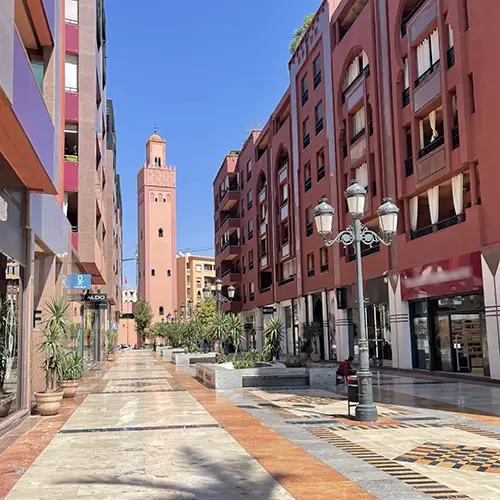
Marrakesh offers a wide range of accommodation, from simple riads to opulent hotels.
The Medina is the most popular area to stay, offering an immersive experience inside traditional courtyard homes called riads. It is chaotic but puts you at the heart of the action.
For a more modern and tranquil environment, Gueliz district provides a European-style city layout with contemporary hotels, international shops, and restaurants.The adjacent Hivernage district is known for its luxury hotels, casinos, and upscale nightlife.
For a resort-style escape, the Palmeraie, a palm grove just outside the city, features sprawling, all-inclusive hotels with large pools, though you will need a taxi to reach the city center.
Best Things to See in Marrakesh: Top Attractions
1. Marrakesh Medina

The Marrakesh Medina is the historic walled center of the city and the setting for most of the best places to visit in Marrakesh. At its heart lies Jemaa el-Fnaa square, the city’s main gathering place and cultural stage.
From here, main arteries spread out into markets selling spices, leather goods, carpets, and handicrafts, while narrow side alleys twist into hidden riads, small hotels, and the homes of local families.

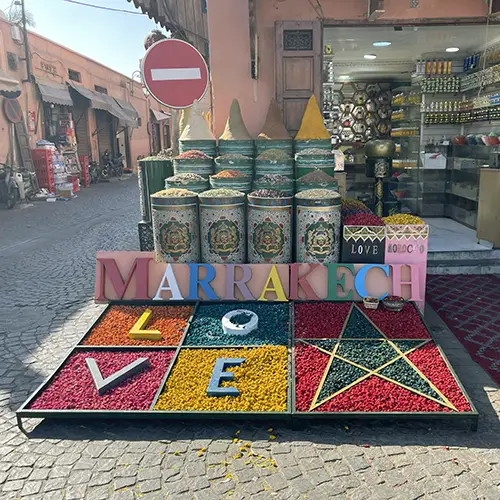
Although the central souks can feel heavily touristic, the medina still retains an authentic character in quieter quarters such as the Mellah (the old Jewish quarter), the northern artisan districts near the Ben Youssef Madrasa, or the residential lanes behind Bab Doukkala.
Simply wandering without a set destination is an experience in itself, as the maze of streets reveals new sights, scents, and encounters at every turn.
2. Jemaa el-Fnaa

This is the main square of Marrakesh. During the day, you will find juice stalls and snake charmers. The square transforms at night with food vendors, storytellers, and musicians. It provides a sensory overload of sound, sight, and smell. Be aware that performers expect payment for photos or watching.
Though considered amongst top attractions of Marrakesh, at daytime the square often feels more like an animal-torturing stage. Snakes are “charmed,” caged monkeys suffer under the sun, and parrots are exploited for photos. While we must mention Jemaa el-Fnaa in this guide, we strongly discourage visitors from supporting any activity that involves the abuse of wild animals.
- Hours and Prices: Open 24/7. Entry is free. Performers expect tips (10–20 MAD / $1–2).
- Time Needed: 30 minutes to explore.
- Combines With: Koutoubia Mosque, the main souks, Bahia Palace.
- Travel Tip: Watch the activity from a rooftop cafe for a less intense experience, especially around sunset.
- 📍Google Maps Location
3. Koutoubia Mosque & Gardens

The Koutoubia Mosque is the largest mosque in Marrakesh. Its minaret is a major landmark visible from much of the city. The structure dates to the 12th century and influenced other regional architecture. Non-Muslims are not permitted to enter the mosque itself. The adjacent public gardens offer a quiet place to rest.
As of late 2025, the minaret is under construction, so expect scaffolding and partial obstruction of views.
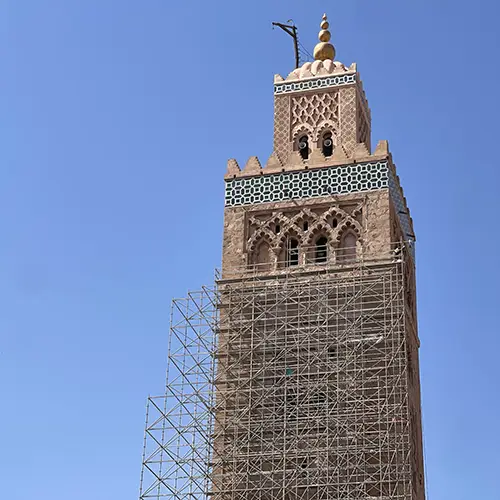

- Hours and Prices: The mosque interior is for worshippers only. Entry to the gardens is free.
- How to Get There: Located next to Jemaa el-Fnaa.
- Time Needed: 30 minutes for the gardens.
- Combines With: Jemaa el-Fnaa.
- Travel Tip: The minaret is illuminated at night, offering good photo opportunities from the square.
- 📍Google Maps Location
4. Bahia Palace (Palais de la Bahia)
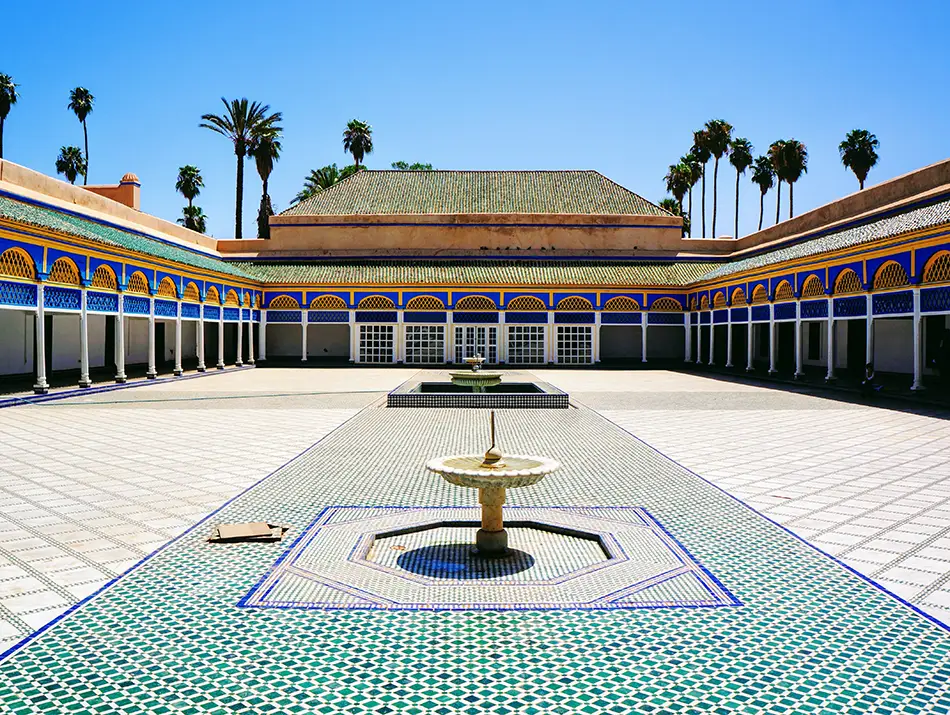
This 19th-century palace showcases intricate Islamic and Moroccan design. It features detailed tilework, painted ceilings, and peaceful courtyards. The palace was built to be the greatest of its time. Not all of its 150 rooms are open to the public.
The palace can be very crowded midday, as it is one of the must-see attractions in Marrakesh.
- Hours and Prices: Open daily 9:00 AM–5:00 PM. Entry is 100 MAD ($10, €9.50).
- How to Get There: A 15-minute walk from Jemaa el-Fnaa in the medina.
- Time Needed: 1–1.5 hours.
- Combines With: El Badi Palace, Mellah (Jewish Quarter), Dar Si Said Museum.
- Travel Tip: Arrive right at opening time to avoid the large tour groups that arrive mid-morning.
- 📍Google Maps Location
5. El Badi Palace (Palais El Badi)
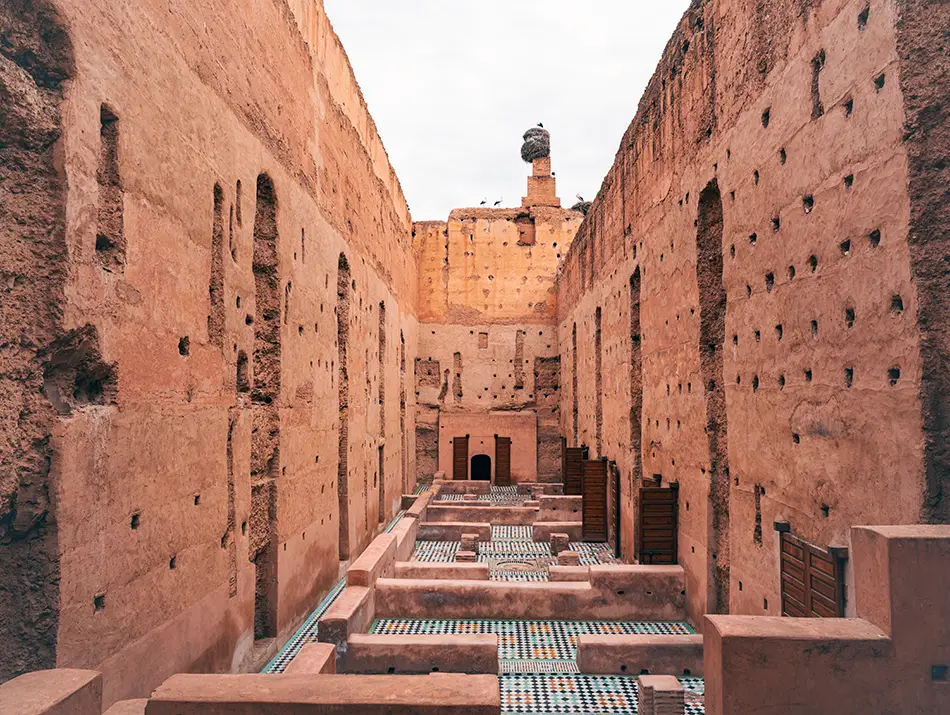
These are the ruins of a 16th-century Saadian palace. Once a lavish complex, it now features a vast courtyard, sunken gardens, and underground passages. White storks can often be seen nesting on the ancient walls.
As of late 2025, the site is under reconstruction and access to the walls is not permitted.
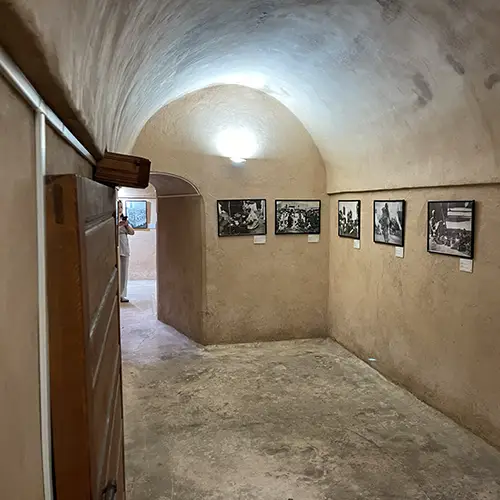

- Hours and Prices: Open daily roughly 9:00 AM–5:00 PM. Entry is 100 MAD ($10/€9.50).
- How to Get There: Located near Bahia Palace and the Saadian Tombs.
- Time Needed: 1–1.5 hours.
- Combines With: Saadian Tombs, Bahia Palace, Mellah.
- Travel Tip: Wear a hat and bring water, as there is little shade in the main courtyard.
- 📍Google Maps Location
6. Saadian Tombs
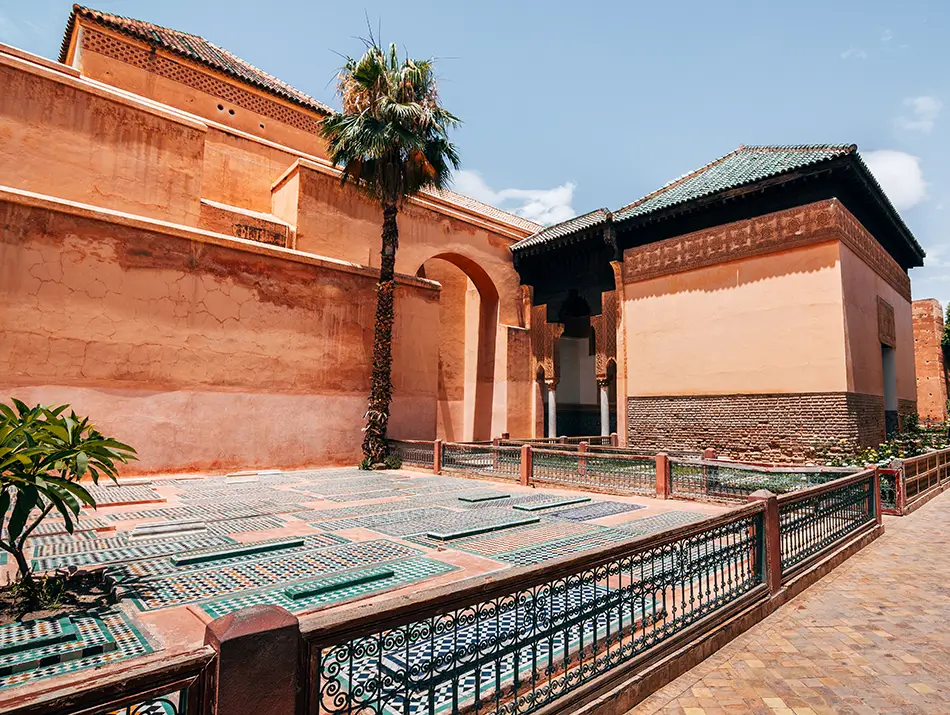
This historic royal necropolis lay hidden for centuries before being rediscovered in 1917 and restored. The tombs house the remains of the Saadian dynasty, with the Hall of the Twelve Columns as the most decorated mausoleum. As one of the best places to visit in Marrakesh, the Saadian Tombs often have long lines to view the main chamber through a small doorway.
- Hours and Prices: Open daily 9:00 AM–5:00 PM. Entry is 100 MAD ($10/€9.50).
- How to Get There: A short walk from El Badi Palace.
- Time Needed: 45–60 minutes.
- Combines With: El Badi Palace, Bab Agnaou.
- Travel Tip: The line for the main mausoleum can be over 30 minutes long.
- 📍Google Maps Location
7. Ben Youssef Madrasa (Medersa Ben Youssef)
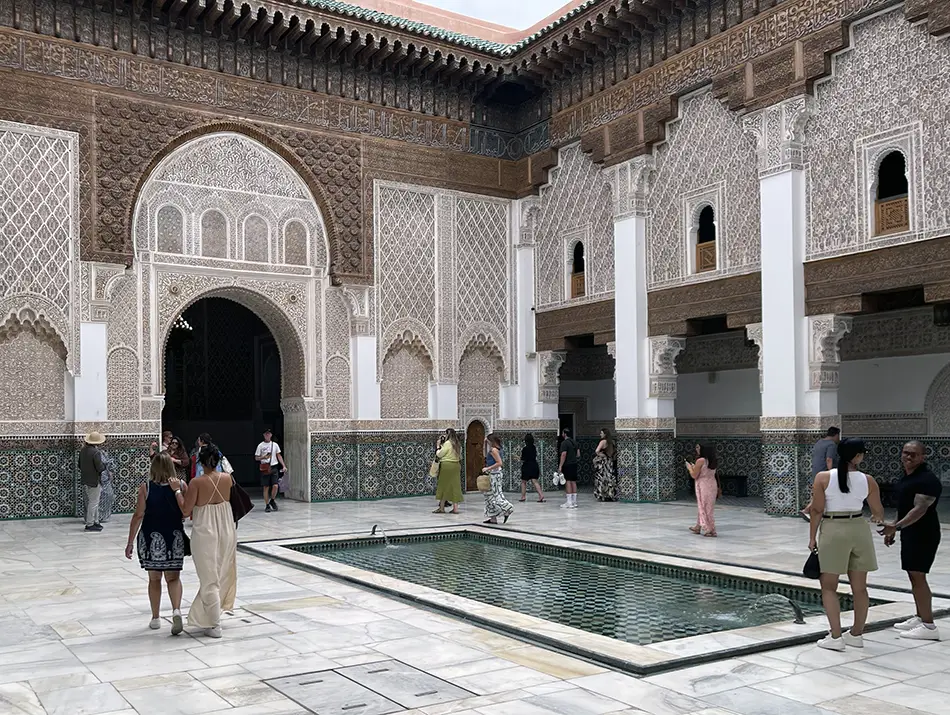
This was once North Africa’s largest Islamic college. The 14th-century building is known for its detailed architecture, with Zellij tilework (geometric mosaics made from hand-cut tiles), carved cedarwood, and stucco inscriptions (plasterwork decorated with Arabic calligraphy and patterns). Visitors can see the central courtyard and freely explore the small student dormitories on their own.
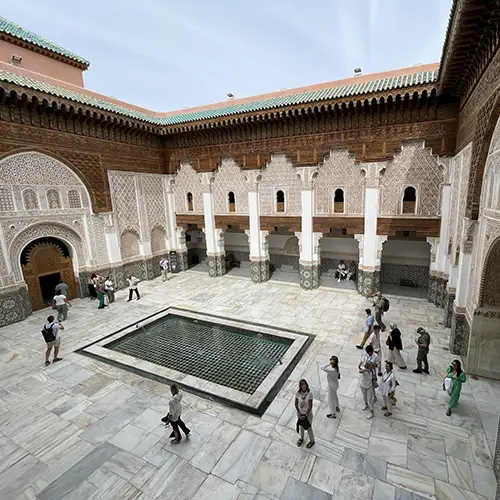

- Hours and Prices: Open daily 9:00 AM–7:00 PM. Entry is 50 MAD ($5/€4.50).
- How to Get There: Located deep in the northern medina, near the Marrakech Museum.
- Time Needed: 45–60 minutes.
- Combines With: Marrakech Museum, Almoravid Koubba, the souks.
- Travel Tip: Be cautious in the surrounding area, as scammers may claim the madrasa is closed and try to divert visitors to the tanneries instead.
- 📍Google Maps Location
8. Jardin Majorelle

This botanical garden was designed by French artist Jacques Majorelle. It was later owned and restored by designer Yves Saint Laurent. The garden is famous for its intense blue accents and collection of cacti. It provides a cool retreat from the city heat. Tickets must be purchased online in advance for a specific time slot.
- Hours and Prices: Open daily 8:00 AM–6:30 PM (last entry 6:00 PM). Timed online tickets required and garden entry is 170 MAD ($17/€15–16).
- How to Get There: Located in the Gueliz neighborhood, a short taxi ride from the medina.
- Time Needed: 1–1.5 hours.
- Combines With: Musée Yves Saint Laurent Marrakech (mYSLm), which is next door.
- Travel Tip: Book the earliest morning time slot to experience the garden with fewer people and better light.
- 📍Google Maps Location
9. Secret Garden (Le Jardin Secret)
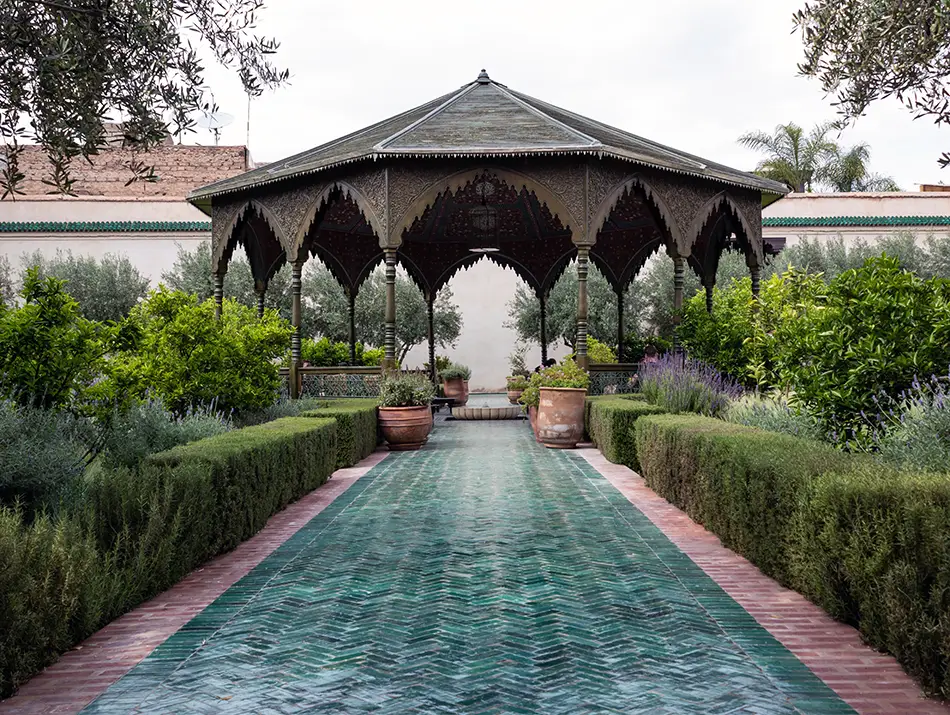
This garden complex is hidden within the medina. It consists of two distinct courtyards: an Islamic garden and an exotic garden.
The design follows traditional Islamic principles. A tower offers elevated views over the medina rooftops. It is a peaceful space away from the busy souks.


- Hours and Prices: Open daily with seasonal variations; entry is 100 MAD ($10/€9–9.50) and tower access is an extra 40 MAD ($4/€3.50).
- How to Get There: Centrally located in the medina, walkable from Jemaa el-Fnaa.
- Time Needed: 1 hour.
- Combines With: Mouassine Museum, the main souks.
- Travel Tip: The tower provides a unique perspective of the surrounding medina architecture.
- 📍Google Maps Location
10. Menara Gardens & Pavilion (Jardin de la Ménara)

These large botanical gardens are located west of the city. They feature olive groves surrounding a large artificial lake. A 19th-century pavilion stands beside the water. The High Atlas Mountains provide a backdrop on clear days. The gardens are popular with locals, especially on weekends.
- Hours and Prices: Open daily 8:00 AM–7:00 PM. Entry is free.
- How to Get There: A 10-minute taxi ride from the medina or a long walk.
- Time Needed: 1–1.5 hours.
- Travel Tip: Visit on a clear weekday morning for the best views of the mountains without the weekend crowds.
- 📍Google Maps Location
11. Other Museums in Marrakesh

Among the Marrakesh top attractions are its diverse museums, which highlight the city’s art, history, and culture. From grand palaces converted into galleries to intimate spaces dedicated to photography or cuisine, these museums offer visitors a deeper understanding of Moroccan heritage.
- Museum of Confluences (Dar El Bacha): Showcases global cultures within a restored pasha’s palace. (📍Location)
- Yves Saint Laurent Museum Marrakech (mYSLm): Dedicated to the work of the fashion designer. (📍Location)
- House of Photography (Maison de la Photographie): Exhibits vintage Moroccan photography from 1870–1960. (📍Location)
- Museum of African Contemporary Art Al Maaden (MACAAL): Features art from Morocco and sub-Saharan Africa. (📍Location)
- Museum of Moroccan Weaving & Carpets (Dar Si Saïd): Displays a collection of Moroccan textiles. (📍Location)
- Marrakech Museum: Housed in a 19th-century palace, it shows Moroccan art and crafts. (📍Location)
- Tiskiwin Museum (Musée Tiskiwin): Presents artifacts from the ancient Saharan trade routes. (📍Location)
- Moroccan Culinary Arts Museum: Explores the history and techniques of Moroccan cuisine. (📍Location)
Best Things to Do in Marrakesh: Top Activities
Beyond sightseeing, Marrakesh activities offer hands-on engagement with Moroccan culture. These experiences range from wellness rituals to culinary lessons. Many can be booked through your hotel, a local agency, or directly with providers.
1. Traditional Hammam Experience
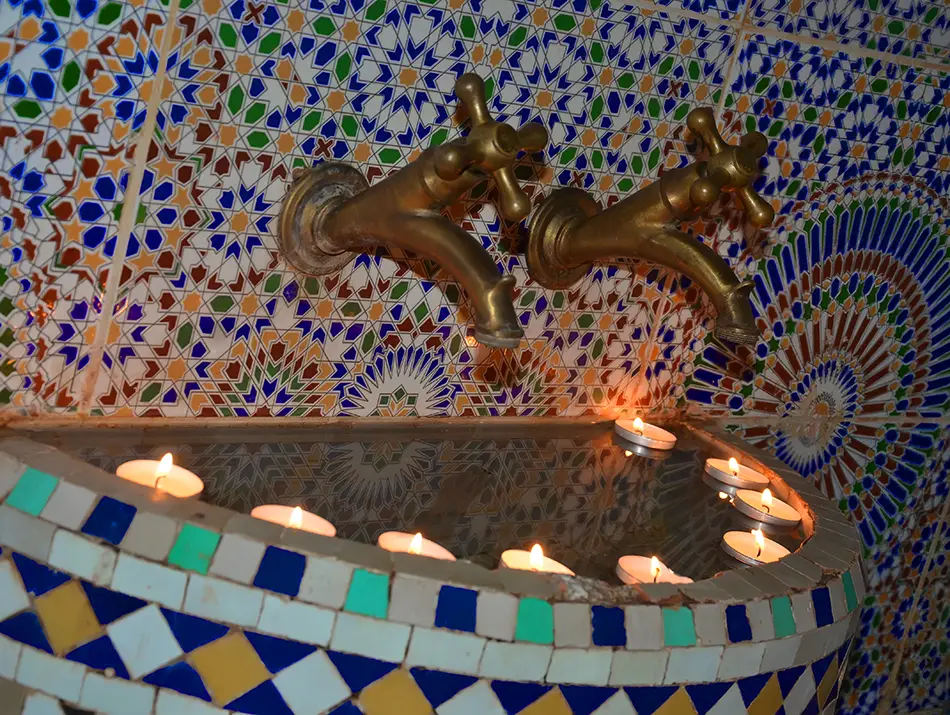
A hammam is a Moroccan public steam bath. The experience involves a series of steam rooms, a black soap scrub, and an exfoliation with a kessa glove. Options range from basic local hammams to luxurious private spas. The traditional scrub is vigorous and not gentle.
- Hours and Prices: Varies. Local hammams cost around 50 MAD ($5/€4.50). Tourist spas start from 300 MAD ($30/€28). Reservations are recommended for spas.
- How to Get There: Hammams are found throughout the city. Spas are often in riads or hotels.
- Time Needed: 1–2 hours.
- Combines With: A relaxing evening after a busy day of sightseeing.
- Travel Tip: For a more authentic experience, visit a public hammam but be prepared for basic facilities and nudity.
2. Moroccan Cooking Class

Most classes begin with a visit to a local market to buy fresh ingredients. Participants typically learn to make a tagine, several salads, and traditional bread. The class ends with eating the meal you prepared.
- Hours and Prices: Half-day classes cost 400–600 MAD ($40–60/€37–55). Reservations are required.
- How to Get There: Many classes are held in riads within the medina or in dedicated schools.
- Time Needed: 3–4 hours.
- Combines With: A visit to the Spice Square (Rahba Kedima).
- Travel Tip: Choose a class with a small group size for more personal instruction.
3. Evening Street-Food Tour

An evening food tour explores the medina’s culinary scene after dark. A local guide leads you to hidden stalls and eateries. You can sample specialties like tagine, mechoui (slow-roasted lamb), and snail soup. The tour often concludes in Jemaa el-Fnaa’s food market.
- Hours and Prices: Tours usually start around sunset and cost 400–700 MAD ($40–70/€37–65). Book in advance.
- Time Needed: 3 hours.
- Combines With: An evening exploring Jemaa el-Fnaa.
- Travel Tip: Come hungry and be open to trying unfamiliar foods for the best experience.
4. Hot-Air Balloon Flight at Sunrise

This activity offers an aerial perspective of the landscape near Marrakesh. Flights take place at dawn over the desert plains or foothills of the Atlas Mountains. The experience includes pre-dawn pickup from your hotel and usually a post-flight breakfast. Flights are weather-dependent.
- Hours and Prices: Prices start around 2,000 MAD ($200/€185). Reservations are essential.
- How to Get There: Tour operators provide round-trip transportation from Marrakesh.
- Time Needed: 4–5 hours, including travel time.
- Combines With: A relaxed afternoon back in Marrakesh.
- Travel Tip: Dress in layers as it can be cold before sunrise, even in warmer months.
5. Walk Explorations

These walks are ideal for travelers who enjoy soaking up local life at a slower pace, even without headline attractions. They offer a chance to see Marrakesh beyond its monuments, observing neighborhoods, daily routines, and the city’s contrasting styles on foot.
- Gueliz District Architecture Walk: Explore the “new city” built during the French Protectorate era. This area features wide boulevards, Art Deco buildings, and modern galleries, offering a strong contrast to the medina. (📍Location)
- Leather Tanneries at Bab Debbagh: Walk through the Bab Debbagh quarter to observe the traditional leather tanning process. The smells are very strong, and you will likely be approached by unofficial guides, who can be pushy and sometimes attempt scams, so caution is advised. (📍Location)
- Mellah (Jewish Quarter) Exploration: Wander the narrow streets of the historic Jewish quarter. Note the different architectural styles, such as outward-facing balconies, and visit the Lazama Synagogue. (📍Location)
- Medina Ramparts Circuit: A long walk along the 12-mile (19 km) perimeter of the old city walls. This route passes by many of the historic city gates (babs).
Best Half-Day and Full-Day Trips from Marrakesh
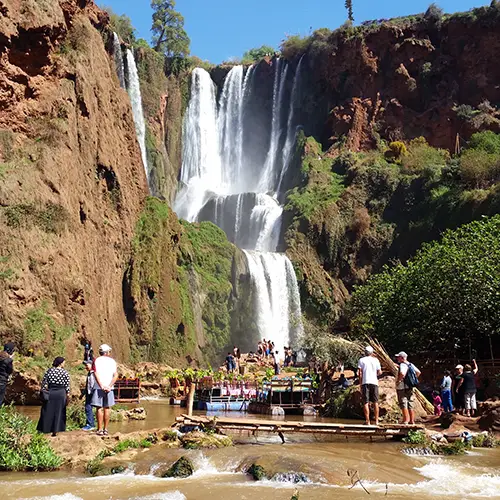
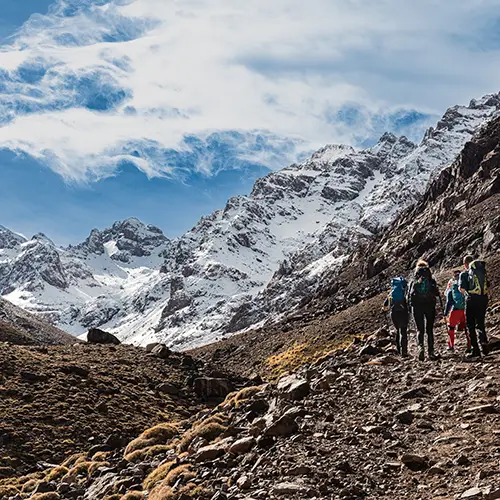
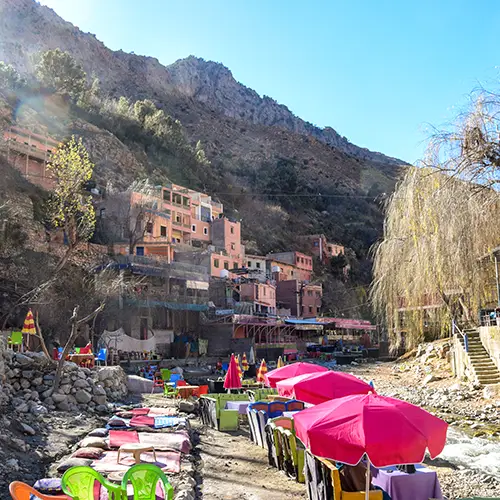
The region around Marrakesh provides diverse landscapes for day trips. You can reach deserts, mountains, and waterfalls within a few hours. These excursions offer a break from the city’s intensity.
Agafay Desert
Agafay is a stone desert located south of Marrakesh. It offers a desert-like landscape of barren hills without the long journey to the Sahara. Activities include camel rides, quad biking, and dining in a desert camp.
Ourika Valley & Setti Fatma
This valley in the High Atlas Mountains follows the Ourika River. The area is known for its Berber villages, riverside cafes, and lush scenery. The village of Setti Fatma is the starting point for a hike to a series of seven waterfalls.
Imlil
Imlil is a small village deep in the High Atlas and the main base for trekking Mount Toubkal, North Africa’s highest peak. The journey passes through the town of Asni and offers views of the Kik Plateau. Even if you are not planning to summit Toubkal, visiting this area is worthwhile for relaxed hiking, exploring Berber villages, and enjoying small waterfalls. For more details, see our Imlil guide.
Ouzoud Waterfalls
These are the highest waterfalls in North Africa. A path allows you to walk down to the pools at the bottom. You can take a small boat to get closer to the falls. Barbary macaques are commonly seen in the surrounding trees.
Aït Benhaddou
This is a fortified village, or ksar, along a former caravan route. Its earthen clay architecture is a classic example of southern Moroccan construction. The drive requires crossing the High Atlas Mountains via the Tizi n’Tichka pass. This is a very long day trip. Some travelers stay overnight nearby to explore the region more deeply.
Marrakesh Itinerary Ideas
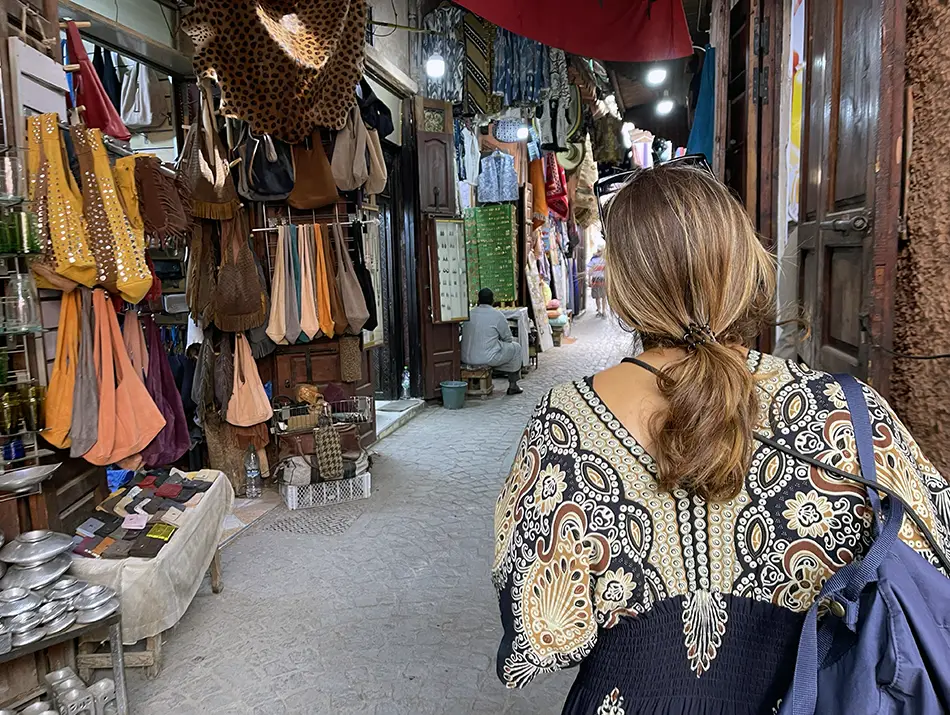
One-Day Marrakesh Itinerary: Medina Essentials
Start at the Koutoubia Mosque to orient yourself. Walk to the Saadian Tombs, then visit Bahia Palace. Spend the afternoon navigating the main souks. End the day at Jemaa el-Fnaa to watch the square come alive at sunset from a rooftop cafe.
Two-Day Itinerary: Culture and Gardens
Follow the one-day itinerary for your first day. On day two, take a taxi to Jardin Majorelle and the mYSLm museum in the morning. Return to the medina to visit the Ben Youssef Madrasa and the adjacent Marrakech Museum. In the late afternoon, enjoy a traditional hammam experience.
Alternative Itinerary: Adventure and Outdoors
Begin with a sunrise hot-air balloon flight over the plains. In the afternoon, go quad biking or take a camel ride through the Palmeraie. On the second day, take a full-day trip to the Ourika Valley or Imlil for a moderate hike in the Atlas Mountains.
Best Sunset Spots in Marrakesh
Marrakesh offers memorable sunset views, especially from above the bustling city. The most popular spots are the rooftop cafes and restaurants surrounding Jemaa el-Fnaa square. From these vantage points, you can watch the sky change color as the square below transforms into an open-air theater of food stalls and entertainers.
Access is easy, though you will be expected to buy a drink or a meal. Arrive early to secure a good seat, as these spots fill up quickly. The air can sometimes be hazy, which can soften the colors but still provides a beautiful, atmospheric scene.
Food and Drinks in Marrakesh
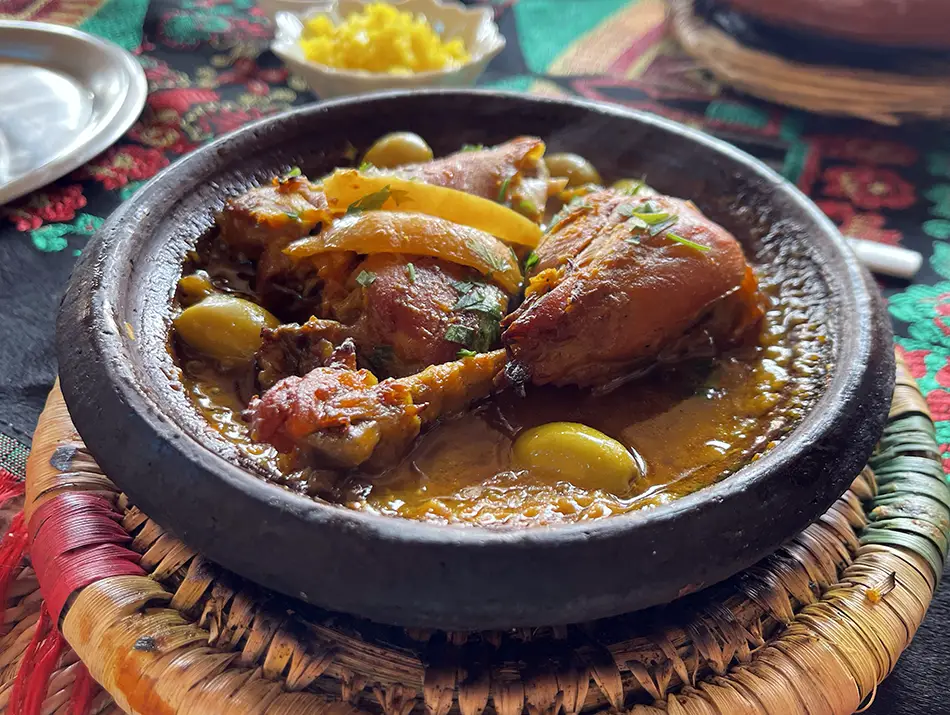
Moroccan cuisine is a highlight of any visit, and Marrakesh offers many unique dishes. Tanjia is a Marrakshi specialty, a slow-cooked meat stew prepared in an urn-shaped clay pot. It is traditionally cooked in the embers of a local hammam’s furnace.
Another must-try is Mechoui, a whole roasted lamb or sheep that is incredibly tender. You can also find excellent Tagine, a slow-simmered stew of meat or vegetables, and couscous everywhere.
A typical local breakfast often consists of fresh bread with honey, argan oil, and Amlou (a sweet almond paste), served with mint tea. For more ideas, see our full guide to the best dishes to try in Morocco.
Local Beverages
The most iconic beverage is Moroccan mint tea, a sweet green tea infused with fresh mint leaves. It is a symbol of hospitality and is served throughout the day. Freshly squeezed orange juice from vendors in Jemaa el-Fnaa is another refreshing staple.
For something different, try an avocado smoothie (jus d’avocat), a thick, creamy drink often blended with dates or milk.
Where to Eat in Marrakesh

The city’s food scene is diverse and exciting. Jemaa el-Fnaa’s food stalls offer an unforgettable dinner experience with grilled meats and traditional dishes. (!! Add rooftops and district where i lived)
For more authentic, local eateries, wander into the alleys north of the square, where you will find small restaurants serving tanjia and tagine at great prices.
The modern neighborhood of Gueliz is the place for international cuisine, trendy cafes, and licensed restaurants serving alcohol. Many riads also offer excellent home-cooked meals, often with a set menu that showcases traditional family recipes.
Nightlife and Evenings in Marrakesh: What to Do After Dark
The nightlife in Marrakesh is a tale of two cities. The heart of the evening is Jemaa el-Fnaa square, where the lively atmosphere continues with street performances and an endless choice of food. This open-air spectacle provides a culturally rich evening for all ages.
For a more Western-style nightlife, head to the modern districts of Gueliz and Hivernage. Here, you will find chic cocktail bars, lounges, and nightclubs that stay open late.
These venues often have a dress code and serve alcohol, catering to tourists and affluent locals. For a deeper look, check out our guide to nightlife in Morocco.
Marrakesh on a Budget
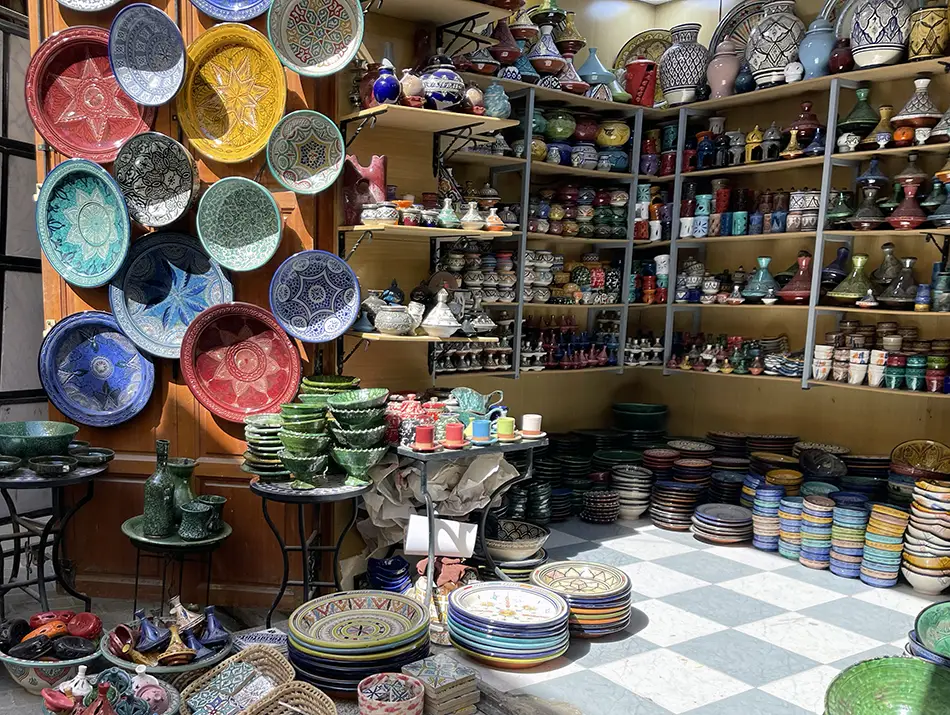
Traveling in Marrakesh on a budget is very achievable with a few local strategies. Eat your main meals at the food stalls or at small “snack” shops in the medina for a fraction of the restaurant price.
Stay in a budget-friendly riad hostels instead of a hotel for an authentic and affordable experience.
Free things to do in Marrakesh include wandering the colorful souks, relaxing in public gardens like Cyber Park, strolling the grounds around Koutoubia Mosque, and watching the daily spectacle in Jemaa el-Fnaa. You can also explore the historic gates and ramparts or wander into local neighborhoods beyond the main tourist areas, all without spending anything.
Sustainable and Responsible Travel Tips
Responsible travel in Marrakesh can make a positive impact. Morocco is a water-scarce country, so be mindful of your water consumption. Support local artisans by purchasing crafts directly from them in the souks rather than from large, generic souvenir shops.
Be cautious of animal tourism; the monkeys and snakes in Jemaa el-Fnaa are often mistreated, and it is best to avoid paying for photos with them.
Know Before You Go
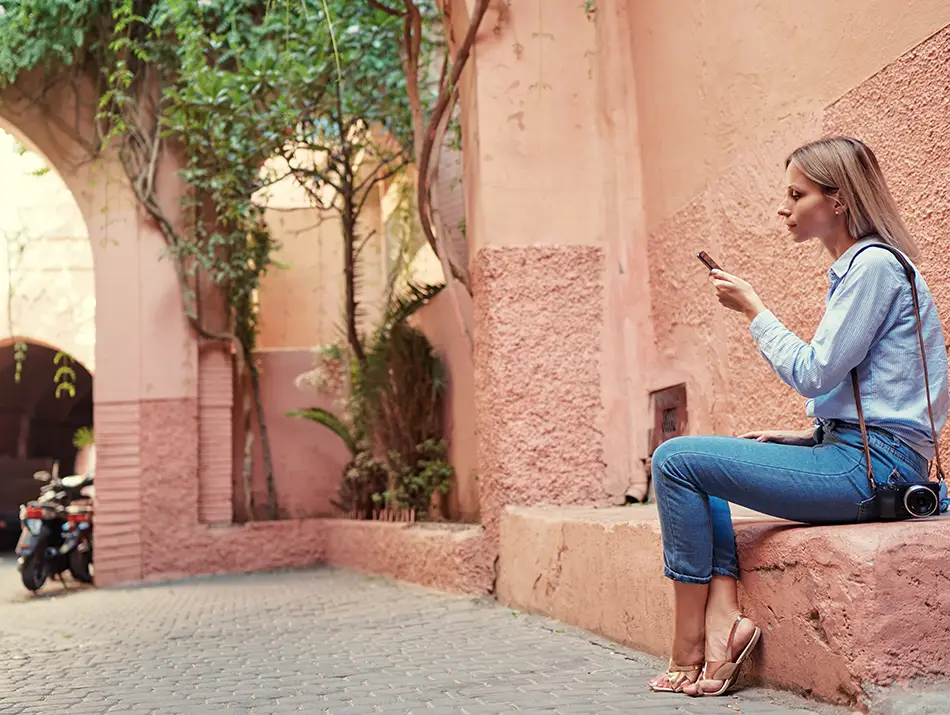
Local Tips
For easier navigation in the medina, download an offline map (we recommend Organic Maps) on your phone before you arrive. Always carry small bills and coins for small purchases, tips, and public restrooms. Be prepared for assertive vendors in the souks. A polite “la, shukran” (no, thank you) is usually effective.
Accessibility
Accessibility in Marrakesh can be challenging for travelers with mobility issues. The ancient medina has narrow, crowded alleyways and uneven cobblestone surfaces that are difficult for wheelchairs. Many traditional riads have steep stairs and no elevators.
However, the newer parts of the city, such as Gueliz and Hivernage, have wider, flatter sidewalks and more modern, accessible hotels and restaurants. Some larger attractions like Jardin Majorelle are partially accessible.
Safety Tips
Safety tips for Marrakesh mostly involve being aware of petty crime and common scams. Pickpocketing can occur in crowded areas like the souks and Jemaa el-Fnaa, so keep your valuables secure. Be wary of overly friendly strangers offering to be your guide, as they will expect payment and may lead you to their family’s shop.
The area most associated with scams in Marrakesh is the tanneries, where many unpleasant experiences can occur. Stay alert if someone approaches you with stories about a special event or something unique happening there “only today,” as this is a common tactic to lure visitors.
Family with Kids Tips
Family-friendly activities in Marrakesh include visiting the colorful Jardin Majorelle and the tranquil Cyber Park. However, the intense crowds and sensory overload of the medina can be overwhelming for very young children. Consider staying in a riad with a pool to provide a quiet escape from the city’s heat and hustle.
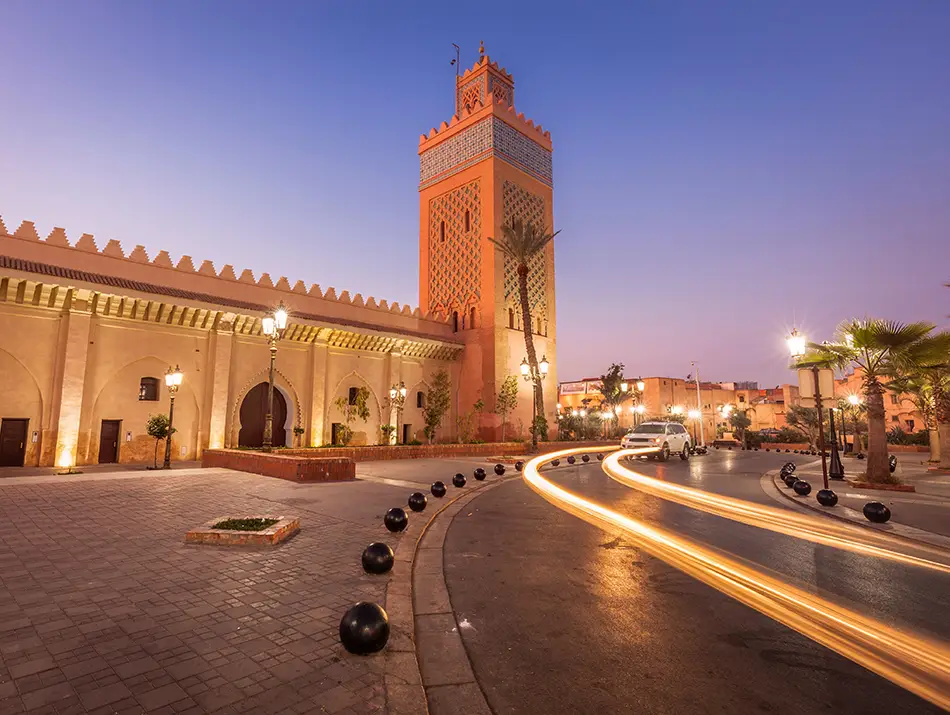
Frequently Asked Questions
Yes, Marrakesh is worth visiting for travelers seeking a vibrant, immersive cultural experience. It is ideal for those who love history, bustling markets, and exotic food. However, if you dislike crowds, haggling, or sensory overload, you might find it too intense.
The best time to visit Marrakesh is during the spring (March to May) or autumn (September to November). The weather is pleasantly warm, perfect for exploring. The off-season in winter offers fewer crowds but cooler temperatures.
Marrakesh is generally safe for solo travelers, including women, but situational awareness is key. Petty theft is a risk in crowded areas. Solo travelers should dress modestly, avoid walking alone in quiet alleys late at night, and firmly decline unwanted attention.
In Marrakesh, try Tanjia, a slow-cooked meat dish unique to the city. Also, sample the Mechoui, a tender roasted lamb found near Jemaa el-Fnaa. Do not miss the various tagines and fresh bread available everywhere.
Without the Hype: Is Marrakesh Worth Visiting?
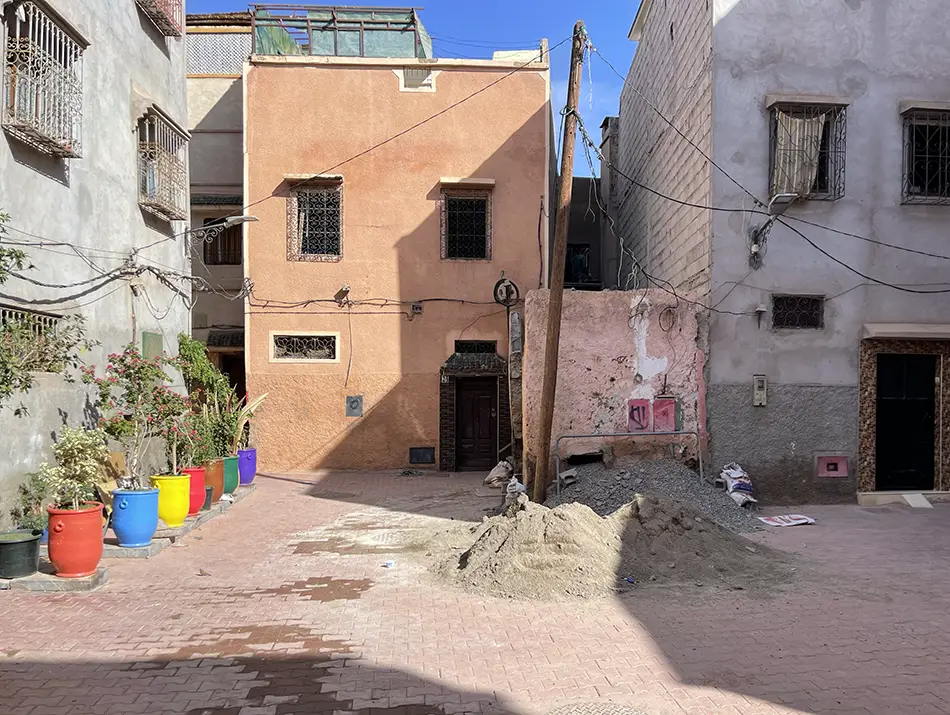
Marrakesh delivers an unforgettable, full-sensory travel experience. It is a city of sharp contrasts, where ancient traditions meet modern life in a chaotic, beautiful blend. The historic sights are impressive, and the energy of the medina is unique. However, the constant hustle, assertive vendors, and need for vigilance can be draining for some.
You’ll like Marrakesh if:
- You thrive in bustling, high-energy environments.
- You enjoy haggling and the treasure-hunt feel of shopping in souks.
- You are fascinated by rich history, intricate architecture, and bold flavors.
You might skip it if:
- You prefer quiet, orderly, and relaxing destinations.
- You are uncomfortable with persistent sales tactics or getting lost.
- You have significant mobility challenges, as the medina is not easily accessible.
Good alternatives:
- Fez: For a more traditional and less tourist-polished medina experience.
- Essaouira: A relaxed, bohemian coastal town with a seaside medina and artistic vibe.
We hope this guide on the best things to do in Marrakesh helps you decide if this vibrant city fits your travel style. For more inspiration, explore our full list of the best places to visit in Morocco. We wish you smooth planning and an unforgettable trip.

